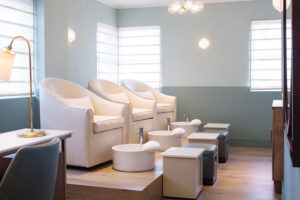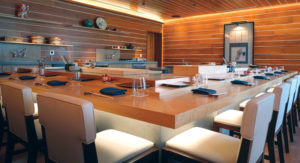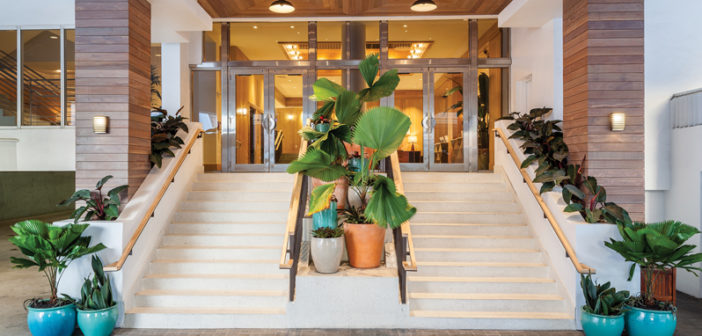In a destination such as Miami’s South Beach, strewn with dozens of branded and boutique hotels, it is important to stand out. Miami-based Key International, owner of the 224-room Marriott Stanton South Beach, embarked on a $22-million, two-phase renovation to do just that, and the additions and improvements led to the boutique-style hotel receiving the resort designation from Marriott International Inc.
Located in the South of Fifth District on famed Ocean Drive, the Art Deco building was built in 1939 and designed by architect Anton Skislewicz. Formerly the South Beach Marriott, it underwent a $10-million renovation upon being added to Key International’s portfolio in 2013. Shawn Gracey, EVP of hospitality, Key International, noted that it was time for another transformation.
“We are long-term investors and bullish on the Miami Beach market. We’ve owned the Marriott Stanton South Beach for nearly 19 years and continue to elevate the guest experience,” he said. “After thoughtful planning, we opted to create new concepts that would transform the property into an all-encompassing lifestyle destination. Following the renovations, we are now able to offer a designated resort experience.”
 According to Gracey, the first phase of the renovation, which began in 2015 and was completed in January 2017, included upgrades to the public spaces, meeting rooms, guestrooms and suites, and the addition of a the Mexican beachside eatery Lolo’s Surf Cantina. Phase two, which started in February 2017 and finished a year later, involved comprehensive upgrades to the Starbucks on property, as well as the additions of the spa and fitness center and Japanese restaurant, Azabu.
According to Gracey, the first phase of the renovation, which began in 2015 and was completed in January 2017, included upgrades to the public spaces, meeting rooms, guestrooms and suites, and the addition of a the Mexican beachside eatery Lolo’s Surf Cantina. Phase two, which started in February 2017 and finished a year later, involved comprehensive upgrades to the Starbucks on property, as well as the additions of the spa and fitness center and Japanese restaurant, Azabu.
About the spa, Gracey said, “Many hotel guests were seeking convenient, on-site options to maintain their health and fitness routines while traveling, so we designed the fitness center to offer a variety of targeted services, plus the availability of personalized one-on-one sessions. We also incorporated specialty training, which consists of functional fitness, movement specialists and yoga.”
Key International used the South Beach ethos as inspiration for the design. “The theme found throughout the property is laid-back luxe,” said Gracey. “Our design team drew inspiration from the resort’s beachfront setting to create a polished and fun style that appeals to travelers of all ages looking to feel at ease.”
Despite being renovated in 2013, the guestrooms have been nearly completely refreshed. “We removed all of the carpeting and added tile flooring, installed new artwork, casegoods and bedding,” said Gracey. “Each bathroom is marble-clad and now features a glass-enclosed rain shower with a hand wand—an upgrade from the previously combined bathtub and shower units. The organic color scheme is continued in the guestrooms, with various hues of white and gray.”
Also part of phase one of the renovations, the public spaces were given a new look including “a full revamp of the arrival area, front desk and exterior patios,” noted Gracey. “Upon arrival, large planters in various sizes line the stairway, adding to the allure of a tropical destination. The front desk boasts a whimsical style with artistic framed prints lining the walls. On the exterior patios, new tile and landscaping were introduced, as well as colorful and plush outdoor sofas, benches and lounge chairs.”
 The two new restaurants were designed by Martin Brudnizki Design Studio, which is based in London and New York. “We wanted to ensure each space could serve as an on-site experience for guests, as well as attract locals,” said Gracey.
The two new restaurants were designed by Martin Brudnizki Design Studio, which is based in London and New York. “We wanted to ensure each space could serve as an on-site experience for guests, as well as attract locals,” said Gracey.
Lolo’s Surf Cantina, the Mexican restaurant, features main dining room walls covered in Mexican textiles and art to provide an authentic feel, while vibrant patterned tile flooring adds a touch of color, according to Gracey.
Azabu features an 80-seat full-service dining room, hidden sushi bar and open kitchen.
“Other design components include wood elements that contrast with a black and white marble top bar,” said Gracey. “A 6-ft. Bonsai fixture draws the eye to the center of the dining room, while glasses are handcrafted by a Japanese artisan.”
Also new the resort is the 1,500-sq.-ft. spa. “It was designed to complement the property’s oceanfront location and the resort’s existing midcentury modern decor,” said Gracey. “There are three treatment rooms in total that mirror a coastal oasis, using elements like textured jute rugs to resemble sand and a nautical color palette. The couples’ suite was designed for optimal relaxation with a rain shower and deluxe soaking tub for use pre- or post-treatment.” HB


